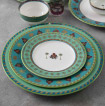It is the 16th century and trade with European companies is gaining sway. Amongst
other luxuries, the Portuguese bring in porcelain that is procured from the Chinese
and sold in India, Persia and East Africa at four to ten times the original price.
Exquisite and exotic, porcelain objects are reserved for the blue-blooded.
China will dominate production of this family of ceramics, until a translucent variation
of porcelain called English bone china is developed in 1797, England. It will soon
become one of Britain’s most profitable trade items and the country will enjoy virtual
monopoly over its production, right up to the late 20th century.
Linked to royal extravagance and the British sahibs thus - in the Indian imagination -
these materials will long linger as signifiers of high living.
In 1955, Bengal Potteries Limited will become the first Indian company to
manufacture bone china, followed by Hitkari Potteries some years after. But in the
initial years, hotels - and not homes - will be their biggest clientele.
Only a generation after Independence, once the middle class is less inhibited and
more style conscious, will bone china reach domestic dinner tables. Floral dinner sets
in particular, will be coveted as indexes of good taste and financial success.
By the next century, plainer versions will be commonly used for routine meals; but
decorative china will still be reserved for special occasions.
Dinner Bowls
Designer: Hitkari Potteries
Year: c. 1960
Bowl with Floret Pattern
Designer: Bengal Potteries
Year: c. 1960
 |
Indus Collection Designer: Good Earth Year: 2005 This bone china tableware inspired by the magical lake Periyar in Kerala Reflected in the blue water of the lake are Verdant Groves of Palm, Banana and Mango Trees. Information Courtesy: Good Earth |
 |
CHAI Designer: Nikita Bhate Year: 2012 This collection draws inpiration from the local, tea culture of India - where teastalls dot every other roadside. Crafted from white porcelain, CHAI comprises of six tea cups and pots for the brew, milk and sugar. |
 |
Urban Tweeter Pitcher Designer: Rayden Design Studio Year: 2015 The Urban Tweeter series is an exercise in abstraction. Organic stoneware and wood evoke a sense of natural living, and the form – reminiscent of a chirping bird – subtly comments on the social habits of the digital age where individuals prefer to tweet rather than simply converse over a cup of tea. |
 |
Mohenjo-Daro Collection Designer: Design Temple Year: 2016 A molten River Indus flows through the crockery, harking back to a 5000-year-old civilization. The patterns on this crockery on each piece are inspired by Harappan handmade pottery such that no two pieces in this set are the same. |



